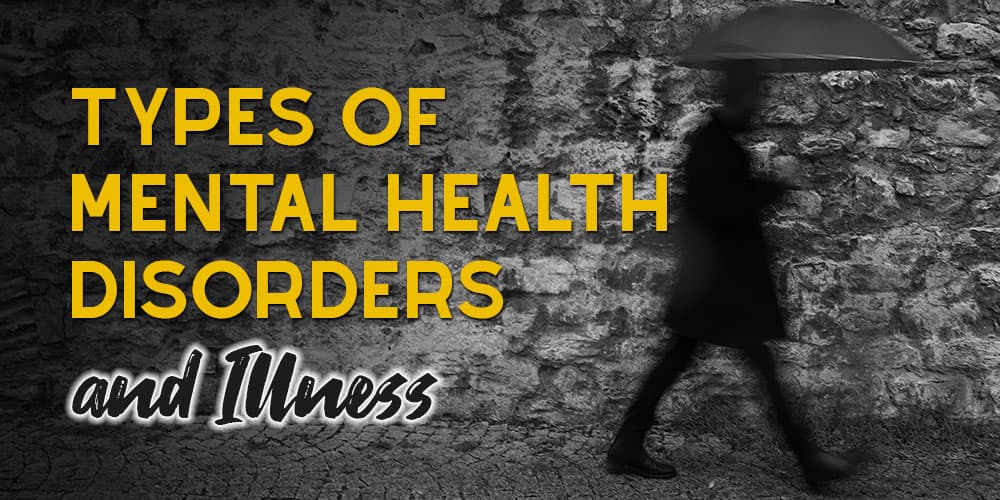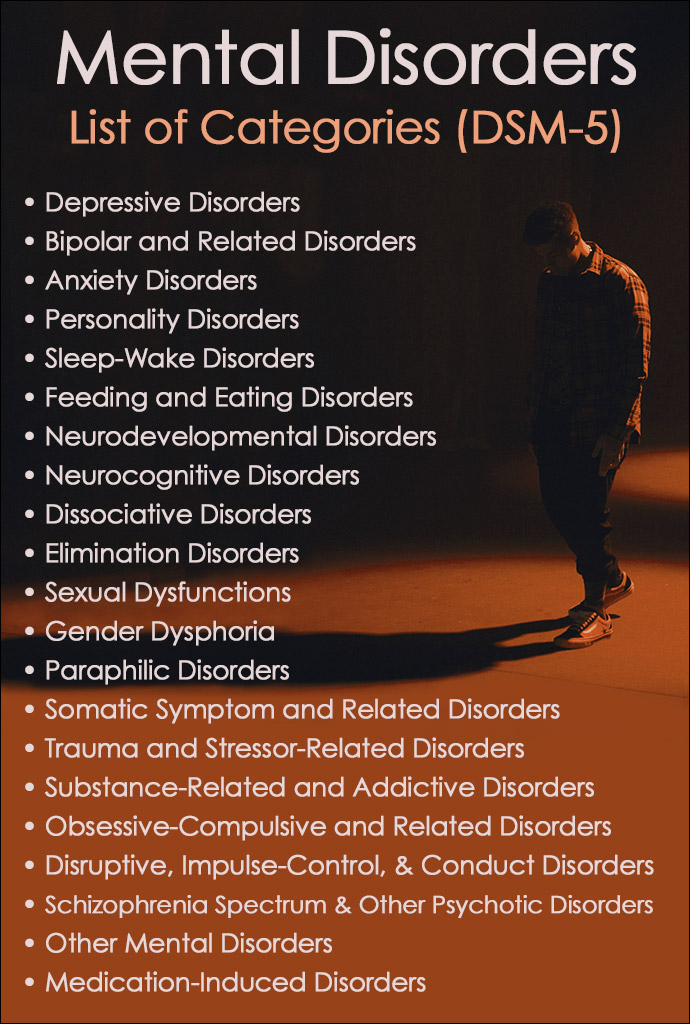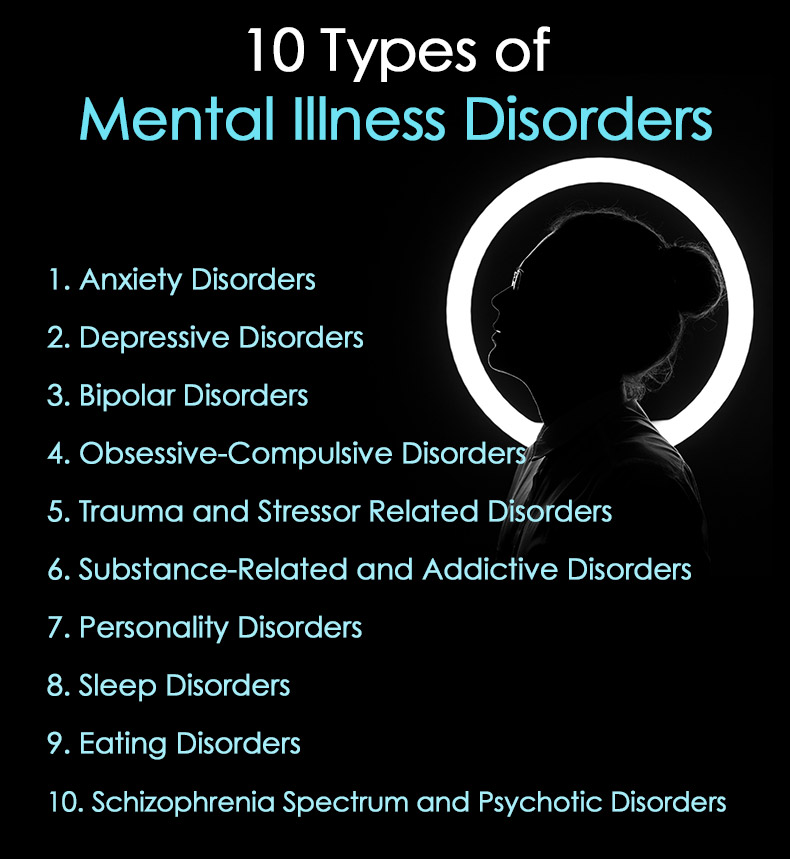
Mental health disorders are conditions that affect a person’s mood, thinking, and behavior.
Living with a mental health disorder can be difficult, but fortunately, most forms of mental illness are treatable.
Because mental health is such an important part of our overall health and wellbeing, it’s necessary to understand the various types of mental disorders, as well as the causes and treatments.
What are Mental Health Disorders?
Mental health disorders, also called mental illnesses, are real health conditions just like heart disease or diabetes.
According to the National Institute of Mental Health, approximately 57.8 million adults experienced living with some type of mental illness in 2021. That number is equal to 1 in 5 American adults.
Mental disorders are responsible for unhealthy issues with emotions, thinking, or behavior.
The symptoms can range from mild to severe depending on the individual and the type of mental illness. However, even mild symptoms can cause disruptions with work, school, and personal relationships.
Common Categories of Mental Disorders Include:
- Anxiety disorders
- Mood disorders
- Personality disorders
- Psychotic disorders
- Eating disorders
- Trauma disorders
- Addiction disorders
While the causes of mental health disorders are complex, there are often multiple factors involved, and many are based on biological or environmental elements.
Causes of Mental Health Disorders
Genetics and brain chemistry can contribute to vulnerability, and environmental circumstances like trauma or substance abuse also influence changes with the brain.
1. Biological Factors that cause mental health disorders include genetics, brain chemistry, and hormonal imbalances.
2. Life Experiences such as trauma, loss of a loved one, stress, and grief can play a role in developing certain forms of mental illness.
3. A Family History of blood relatives with a mental illness may be a factor for other family members to develop similar conditions.
4. Environmental Factors like discrimination, income, or drug and alcohol abuse can shape the development of mental disorders.
5. Some specific mental health disorders may have more defined causes like the following:
Anxiety disorders can arise after trauma but may also run in families.
A substance induced disorder can develop from using certain types of drugs or medications.
Mood episodes with bipolar disorder can be triggered by chemical changes or dysregulation of neurotransmitters in the brain.
Schizophrenia may be connected to gene development in the brain beginning before birth.
Despite varying causes, most mental illnesses are highly treatable through a combination of medications and therapy to develop coping mechanisms for the symptoms.
Mental Disorders List in the DSM-5
The Diagnostic and Statistical Manual of Mental Disorders (DSM-5) classifies over 20 different types of mental health disorders diagnostic criteria and codes.
DSM-5 Mental Disorders List of Categories
- Depressive Disorders
- Bipolar and Related Disorders
- Anxiety Disorders
- Obsessive-Compulsive and Related Disorders
- Trauma and Stressor-Related Disorders
- Substance-Related and Addictive Disorders
- Personality Disorders
- Sleep-Wake Disorders
- Feeding and Eating Disorders
- Schizophrenia Spectrum and Other Psychotic Disorders
- Neurodevelopmental Disorders – (ADHD, Autism)
- Neurocognitive Disorders (Alzheimer, Parkinson’s Disease)
- Dissociative Disorders
- Somatic Symptom and Related Disorders
- Elimination Disorders
- Sexual Dysfunctions
- Gender Dysphoria
- Disruptive, Impulse-Control, and Conduct Disorders
- Paraphilic Disorders
- Other Mental Disorders
- Medication-Induced Movement Disorders and Other Adverse Effects of Medication
The DSM-5 categorizes mental disorders into over 20 main types, with hundreds of specific disorders that fall under these broader categories.
This comprehensive classification system helps mental health professionals diagnose patients based on clusters of symptoms.

10 of the Most Common Mental Health Disorders
Outlined below are 10 of the most common mental health disorder categories with a brief description of each one.
1. Anxiety Disorders
Anxiety disorders are a category of mental illnesses characterized by excessive, irrational fear and anxiety that impacts daily functioning.
The World Health Organization (WHO) states anxiety disorders are the most common mental illness impacting over 300 million people worldwide in 2019.
Generalized Anxiety Disorder (GAD) involves frequent and exaggerated worry that is difficult to control. About 2.7% of adults in the United States experience GAD in a given year.
Social Anxiety Disorder (SAD), also known as social phobia, is associated with intense fear and avoidance of social situations due to feelings of embarrassment or humiliation. It impacts approximately 7% of American adults per year.
Panic Disorder features suddenly recurring panic attacks and living with the fear of another attack.
Specific Phobias induce an intense fear of specific objects or situations.
Over 19% of American adults are estimated to be living with an anxiety disorder, making this the most common category of mental illness in the United States.
Even though it is not an official diagnosis, many people live with high functioning anxiety that makes daily living difficult despite being able to carry out work and personal responsibilities.
2. Depressive Disorders
Depressive disorders are a category of mental illness characterized by persistent feelings of sadness, hopelessness, and loss of interest in usual activities.
The main types of depressive disorders are:
Major Depressive Disorder involves severe symptoms that interfere with the ability to work, sleep, study, eat, and enjoy life. There may be a single episode or recurrent episodes.
Persistent Depressive Disorder is associated with a depressed mood lasting at least 2 years, although there may be periods of major depression along with periods of less severe symptoms.
Premenstrual Dysphoric Disorder (PMDD) causes depressive symptoms, irritability, and anxiety in the week or two prior to menstruation during most menstrual cycles. Roughly 3% to 8% of menstruating women experience PMDD.
Disruptive Mood Dysregulation Disorder is comprised of chronic, severe, and persistent irritability in children and adolescents that interferes with normal functioning.
Approximately 7% of American adults have had at least one major depressive episode in a given year, although nearly 20% of people have experienced clinical depression at some point in their life.
With treatment, most people with depression can feel better and regain their ability to function in daily life.
3. Bipolar Disorders
Bipolar disorders are a category of mental health disorders characterized by extreme shifts in mood and energy levels.
The 4 types of bipolar disorder include:
Bipolar I Disorder causes manic or mixed episodes that last at least 7 days and depressive episodes typically occur as well.
Bipolar II Disorder includes patterns of depressive episodes that shift back and forth with hypomanic episodes, but not full manic episodes.
Cyclothymic Disorder is a milder form of bipolar that consists of numerous hypomanic symptoms and depressive symptoms lasting for at least 2 years.
Other Specified and Unspecified Bipolar Disorders are conditions with bipolar symptoms that do not meet the clinical criteria for one of the three disorders above.
With medication and psychotherapy treatment, many people with bipolar disorder can manage mood swings and function normally.
4. Obsessive-Compulsive Disorders
Obsessive-compulsive disorders (OCD) are characterized by unwanted, intrusive thoughts (obsessions) and repetitive behaviors (compulsions) that drive a person’s actions. The main types are:
Obsessive-Compulsive Disorder (OCD) features obsessions or compulsions that consume over 1 hour per day and cause significant distress or impairment.
Hoarding Disorder is marked with a persistent difficulty discarding possessions due to distress associated with getting rid of anything.
Body Dysmorphic Disorder (BDD) is related to an excessive preoccupation with an imagined or minor defect in physical appearance.
Trichotillomania is an irresistible urge to pull out one’s own hair.
Excoriation Disorder, also called skin-picking disorder, features recurrent picking of the skin to the point of tissue damage.
These types of mental disorders are generally treated through cognitive behavioral therapies focused on modifying obsessive thoughts and habits. Antidepressants can also be helpful in some cases.
Some famous people with OCD have spoken publicly about how treatment has helped them manage their condition.
5. Trauma and Stressor Related Disorders
Trauma and stressor-related disorders are a type of mental illness caused by experiencing or witnessing a traumatic event. The most common types are:
Post-Traumatic Stress Disorder (PTSD) develops after exposure to a terrifying or traumatic event with symptoms that generally include flashbacks, nightmares, and severe anxiety.
It’s important to note there are different types of PTSD and a proper diagnosis is helpful for effectively treating it.
Acute Stress Disorder can occur after a traumatic event with dissociative symptoms such as detachment, anxiety, or loss of memory of the event. It often lasts between 3 days to a month after the trauma.
Adjustment Disorders are characterized by emotional or behavioral symptoms within 3 months of a stressful experience.
Other Specified Trauma Disorders is a category that includes psychological responses causing significant distress that do not meet the criteria of other categories.
It’s estimated that trauma disorders impact 10% to 20% of the general population at some point in a lifetime.
These conditions can be treated with psychotherapy, EMDR Therapy, neurofeedback, yoga, and other therapies that aid in processing the trauma.
Medications may be beneficial for managing anxiety and depressive symptoms.
6. Substance-Related and Addictive Disorders
Substance use addiction disorders occur when prolonged or excessive use of alcohol, drugs, nicotine, and other substances cause impairment, judgement, cravings, health problems, and an inability to meet daily responsibilities at work, school, or home.
The main types of substance addictions are:
Alcohol Use Disorder features compulsive alcohol use despite negative effects.
Drug Use Disorder – This includes the misuse and dependence to legal or illegal drugs like opioids, cocaine, prescription medications, marijuana, and others.
Nicotine Addiction and dependence is estimated to affect over 16% of American adults, or 40 million people.
Inpatient and outpatient behavioral therapy and medication-assisted treatment are effective for lasting addiction recovery for many people. Support groups can be used after treatment for extended relapse prevention.
7. Personality Disorders
Personality disorders are a category of mental illness that include inflexible patterns of thinking and behaviors that differ significantly from cultural norms.
They can lead to distress and impairment that is not attributed to another mental disorder.
There are 10 main types that are grouped into 3 different personality disorder clusters with similar characteristics.
Borderline Personality Disorder (BPD) causes unstable emotions, relationships, personal self-image, and impulsive behavior.
Narcissistic Personality Disorder (NPD) is linked to extreme feelings of self-importance, a need for excessive admiration, and a lack of empathy for others.
Antisocial Personality Disorder (ASPD) is defined by a disregard for the rights of others, a violation of social norms, deceitfulness, and a lack of remorse.
Avoidant Personality Disorder is connected to extreme social inhibition and feelings of inadequacy.
Obsessive-Compulsive Personality Disorder (OCPD) is experienced as rigid perfectionism and an overt need for order.
Psychotherapy is helpful for learning coping strategies to overcome nonadaptive thoughts and behaviors.

8. Sleep Disorders
Sleep disorders are a category of conditions characterized by disruptions in the quality, timing, and amount of sleep that lead to impaired functioning and stress. The most common sleep disorders are:
Insomnia is a difficulty falling or staying asleep despite wanting to sleep.
Sleep Apnea causes repeated pauses in breathing during sleep.
Narcolepsy causes periods of extreme daytime sleepiness.
Circadian Rhythm Sleep-Wake Disorders are sleep disruptions related to a mismatch of the body’s internal clock and external environment.
9. Eating Disorders
Eating disorders are related to extreme, unhealthy eating behaviors centered around concerns about weight, food, or body image. The main types are:
Anorexia Nervosa is known by a restricted calorie intake that can lead to dangerously low body weight and a fear of gaining weight.
Bulimia Nervosa includes cycles of binge eating followed by purging through vomiting, the use of laxatives, or excessive exercise.
Binge Eating Disorder occurs by consuming large amounts of food in a short period of time without purging afterwards.
10. Schizophrenia Spectrum and Other Psychotic Disorders
Psychotic disorders create a distorted awareness or thinking that is not grounded in reality. The main types of psychotic disorders are:
Schizophrenia is a mental illness that causes disordered thinking, emotions, and perceptions along with abnormal behaviors and speech.
Schizoaffective Disorder includes symptoms of schizophrenia combined with a major mood disorder.
Schizophreniform Disorder features schizophrenic symptoms that last anywhere from 1 to 6 months that are not related to external causes like substance abuse or medical conditions.
Brief Psychotic Disorder presents as sudden psychotic symptoms such as delusions, hallucinations, or incoherent speech that lasts between 1 day and 1 month.
These often-disabling conditions commonly arise in the late teens to mid-twenties. With long-term antipsychotic treatment and psychosocial interventions, recovery outcomes have improved significantly in recent years.
Treatment for Mental Health Disorders
Today there are many treatment options available to help those living with mental illness lead a happy and fulfilling life.
Treatments for Mental Health Disorders include:
1. Medication
Different classes of psychiatric medications are prescribed to help regulate key neurotransmitters contributing to symptoms like depression, anxiety, psychosis and others.
2. Psychotherapy
Psychotherapy or talk therapy helps patients understand the root causes of their condition, negative thought patterns and behaviors, and developing coping techniques and social skills to address triggers and prevent relapse.
3. Dual Diagnosis
Some mental illnesses co-occur with substance use addiction requiring both conditions to be treated at the same time, which is known as dual diagnosis treatment.
4. Brain Stimulation Therapies
TMS Therapy and ECT stimulation aid treatment-resistant depression and certain conditions by regulating the brain and mood.
5. Support Groups
Support groups like Alcoholics Anonymous and other after-treatment groups provide a community of others who share the same condition to offer accountability and effective coping strategies for substance abuse and mental health disorders.
6. Lifestyle Changes
Lifestyle Changes like diet, exercise, sleep quality, and practicing stress reduction techniques are often overlooked, yet they can be effective for reducing anxiety or depression and complement the other treatments mentioned.
With compassion and understanding, many mental illnesses often respond well to treatment over time and lead to a successful recovery.
Mental health disorders are more common than most people realize.
Identifying the symptoms and seeking treatment early at the first signs can dramatically improve the quality of life for those with a mental health illness.
Related Posts
- Psilocybin Therapy for Depression Treatment and Mental Health
The push to find new and effective treatment approaches for mental health issues like Psilocybin…
- Mental Health Awareness Month in May
May is Mental Health Awareness Month. Humans have been working to unravel the mysteries of…
- What are 10 Personality Disorders and 3 Types of Clusters?
Many mental health conditions often overlap with each other and share similar characteristics. Grouping them…
